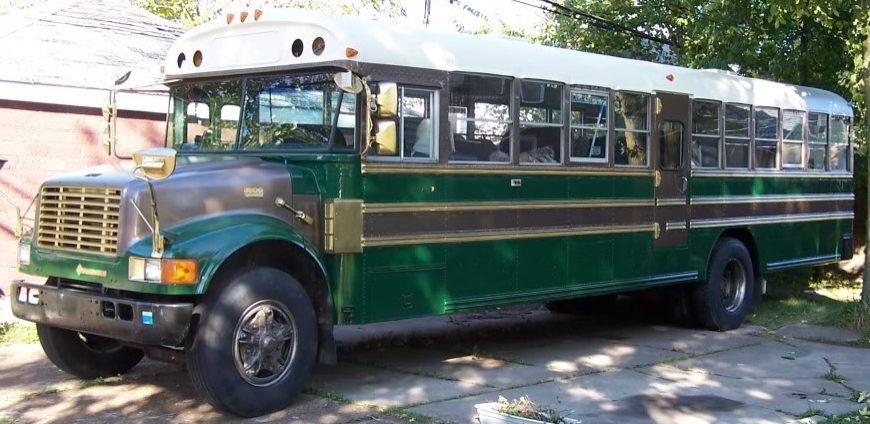So, armed with a plan, the bus floor needed to go. You might remember school bus floors as being a black … surface, hard, but not totally unyielding. Generally, that covering is of a black rubber material. On some buses, it’s right over the metal floor, but on our bus, it was over 3/4″ marine-grade plywood.
But before I could get to removing the floor, there was one last thing to remove, the back heater. Some people who convert Skoolies leave them in place so that they can use the engine heat to warm the whole bus, some keep them for an extra ‘heat sink’ when climbing long hills and such. I decided to take ours out, as we were toying with the idea of radiant heating in the floor. Well, that and the fact that the coolant tubes ran from the front of the bus to the heater in the back along and under the port wall, taking up space.
 |
| See all the shiny metal along the floor on the port side wall that just is missing on the starboard side? Yeah, that’s all covering coolant lines and the helper pump. |
 |
| And here’s where it goes under the port emergency door, then comes back up. |
So, removing the heater unit wasn’t so bad. Just a couple of bolts on the side (since the top had been fastened to a seat-frame), and it was loose. But there was all that tubing, and most all of the phillips-head screws on the floor had been heavily rusted. See, one thing those rubber floors are really good at is being fairly impermeable to liquids. Like the water from kids’ shoes on rainy days, and the salt and snow (which becomes a brine when it melts) from kids’ boots in the winter. And of course, that sets up a perfect rusting situation for all those screw heads – but not necessarily the rest of the screw shank.
Unfortunately, I don’t have pictures of the floor tear-up. It wasn’t very glamorous, and I was more concerned about getting the floor out to think to take pictures. (And, since I still have a little to do, I’ll remember to take some pictures of that later.) But a quick description will probably tell you what you are wondering about for the floor itself.
First, the rubber had to come out. Some of it, like the middle ‘walkway’ strip came out pretty much intact, needing a flat pry bar (Wonderbar-type) to get some of the adhesive to let go, and then a whole lot of pulling. The stuff that was on the sides was a bit tougher, mostly due to where the seats had been bolted to the floor. The extra cinch of the bolts made those areas adhere really well and cause the rubber to rip, so this was an extremely frustrating exercise.
The next bit was the marine-grade plywood. I first tried to just pry it up by one of the emergency doors, with a big (almost 4′ long) bar. The after a whole lot of effort, the plywood started to crack, and I knew that wasn’t going to be the way. What I found, after the rubber was removed, was that each sheet of the plywood was fastened down to the floor with a generous number of mostly rusted 14 gauge screws (about 1/4″ in diameter for the shank) that were about 1″ long, going right down through the steel under the plywood. With my impact driver, I was able to get many of these out, allowing me to pry up most of the sheets intact, right up to behind the driver’s seat by the front door, which I didn’t want to tangle with just yet.
Now, some of the screws pulled through, and some of those smaller screws that had rusted heads pulled through too, leaving a dangerous potential for tetanus for the unwary, barefooted walker. These, though came out with vice grips & patience, or the angle-grinder. This, you would think, would leave a relatively clean floor, but not so. There was, of course, adhesive under the plywood, and the seams of the metal floor, and then the seams between the sheets of plywood were actually ‘caulked’ with a bead of butyl sealant, which stays amazingly sticky and resists cleaning.
And then there were all the screw and bolt-holes in the steel, and, since the rubber does a great job of being a water barrier and these holes all lead to the underside of the bus where all the water can spray up, rust. But most all of the rust was surface rust, and was cleaned up in an afternoon with the angle-grinder set with a wire wheel. Once clean, the floor got a coat of black Rustoleum with a roller, and when dry, silicon caulk filled the holes.
Whew!
(more in Floors & Walls)



